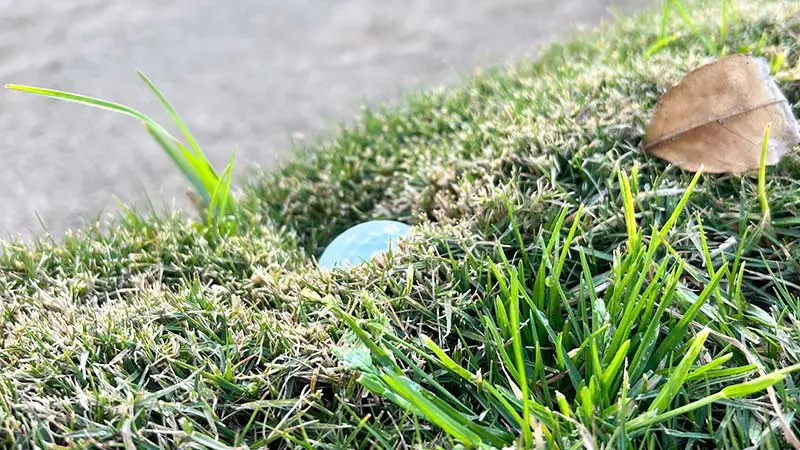Golfers, get ready for some significant changes to the Rules of Golf starting January 1. Among the 30 updates, the rule on embedded ball relief stands out as one that could impact your game right from the first hole.
Previously, relief for an embedded ball was limited to closely mown areas, but now the new rule offers broader relief across the general area.
Under the old rule, players needed a Local Rule to get relief for an embedded ball in the rough. The new Rule 16.3 flips this, providing automatic relief unless a Local Rule states otherwise.
This shift simplifies the process, ensuring more consistent play. As you prepare for the upcoming season, understanding these changes will help you navigate the course with confidence and stay within the rules.
Understanding the Golf Embedded Ball Rule
The embedded ball rule in golf allows a player relief when their ball becomes embedded in its own pitch mark in the ground, typically in soft ground conditions like wet grass or soil.
Here’s a breakdown of the rule:
Overview of the Rule
The Golf Embedded Ball Rule clarifies when players can receive relief for a ball embedded in its own pitch mark.
According to the Rules of Golf, an embedded ball occurs when a stroke causes the ball to become embedded in the ground due to its impact, leaving a discernible pitch mark. For a ball to qualify as embedded, at least part of it must be below the level of the ground in its own pitch mark.
Relief allows a player to lift, clean, and drop the ball without penalty. However, it’s essential that the pitch mark belongs to the player’s last shot, not a different golfer’s unrepaired mark.
Changes in the Rule for 2023
The 2023 adjustment to the embedded ball rule expands relief options. Previously, Rule 25-2 limited relief to closely mown areas, such as fairways.
Now, players can obtain relief for embedded balls in the general area, including roughs. This change streamlines the process and removes the need to invoke a Local Rule for such relief.
If there’s reasonable evidence that the pitch mark belongs to the player’s shot, they can treat it as embedded and take the appropriate relief steps.
The updated rule aims to enhance fairness and pace of play, ensuring that golfers are not unduly penalized by unfavorable course conditions.
It’s essential to familiarize yourself with these adjustments to fully benefit from the 2023 changes. Always consult the official rulebook or a rules official if in doubt.
Conditions for an Embedded Ball
The conditions for an embedded ball in golf are relatively straightforward:
What Qualifies as an Embedded Ball?
An embedded ball is one that is stuck in its own pitch mark in the ground due to the impact of a stroke. For relief to be granted, the ball must be in a condition where it leaves a visible impression in the soil.
According to Rule 16.3, relief is permitted in the general area, which includes all parts of the course except for the teeing area, green of the hole, penalty areas, and bunkers.
It’s critical to confirm that the ball is embedded in your pitch mark, not one made by another golfer. In case of doubt, relief can be taken if it’s reasonable to conclude that the pitch mark is yours based on available information.
Where Embedded Balls Commonly Occur on the Course
Embedded balls frequently occur in the fairway and the rough. Following the rule change in 2019, relief is available for embedded balls in any area classified under the general area, which encompasses most of the golf course excluding specific zones like penalty areas and bunkers.
Although balls can also embed in sand higher than fairway height, they don’t qualify for automatic relief unless specified by a Local Rule.
High-traffic areas such as near the green or landing zones on the fairway are common spots for embedded balls due to frequent strokes altering the ground conditions.
The 2022 Players Championship highlights an instance where understanding the embedded ball rule is crucial.
Paul Casey’s shot ended in an embedded ball situation, but video evidence showed the ball wasn’t in his pitch mark, demonstrating the importance of correctly identifying the origination point of the pitch mark for relief eligibility.
How to Handle an Embedded Ball
Handling an embedded ball in golf involves following specific steps to ensure fair play and adhere to the rules of the game.
Here’s a guide on how to handle an embedded ball:
Steps for Proper Relief
Players must follow certain steps to handle an embedded ball correctly. A player should first verify the ball is embedded in its own pitch mark. If there’s uncertainty about who made the mark, it’s reasonable to treat it as embedded if evidence supports it.
Next, the player should mark the spot right behind the ball. After marking, the player should drop the ball within one club length from the mark, no nearer the hole, ensuring the drop area remains within the general area.
This means avoiding areas like greens, bunkers, and penalty zones. The player should then play the ball as it lies in the new position.
Penalties for Misapplication of the Rule
Failure to correctly handle an embedded ball results in penalties. If a player claims relief for a ball embedded in another player’s pitch mark or without sufficient evidence that it’s their pitch mark, it can lead to a stroke penalty for playing from a wrong place.
In some cases, if the ball is played from a significantly incorrect location, it results in disqualification.
Players must exercise diligence in verifying the embedded ball’s status and follow proper drop procedures to avoid incurring penalties.
Accurate identification and adherence to rules ensure fair play and compliance with established golfing standards.
Key Differences in Relief Options
In golf, there are various relief options available to players depending on the situation.
Here are some key differences between them:
Relief in the General Area
Relief for an embedded ball in the general area is straightforward. Players drop the ball within one club length of the spot immediately behind its original location, staying within the general area.
This area, previously known as “through the green,” includes rough and fairways. Relief is not allowed if the ball is embedded in sand unless the sand is in a closely mown area. Correct identification of the original pitch mark is essential for this process to be valid.
Relief on the Putting Green
Relief procedures differ on the putting green. When a ball gets embedded on the putting green, players must mark the spot before lifting it, repair the pitch mark, and then replace the ball at its original spot.
Free relief includes marking the ball before lifting it, ensuring no deviation from the original position. This rule emphasizes the importance of maintaining the condition of the putting green.
Additionally, it helps ensure fair play and consistency across the game. Adhering to these procedures not only respects the rules but also promotes good sportsmanship and etiquette in golf.
Relief in a Bunker
Relief for an embedded ball in a bunker has specific constraints. No free relief is provided for a ball embedded in a bunker; players cannot automatically drop outside the bunker without incurring a penalty.
To proceed without penalty, players drop the ball within the bunker, following the same procedure used for the general area, ensuring it drops within one club length behind where the ball was embedded.
These distinctions underscore the need for players to correctly interpret and apply the relief rules based on the ball’s location on the course. Proper application of these rules ensures compliance and maintains the integrity of the game.
Frequently Asked Questions
How do you know if a ball is embedded?
An embedded ball is one that is stuck in its own pitch mark due to stroke impact, with part of the ball below the ground level and a visible impression in the soil.
What happens if you can’t find a plugged ball?
If you can’t find your ball within three minutes, it is considered lost. You must return to the spot of your previous stroke and play another ball with a one-stroke penalty as per Rule 18.2b.
What club to use when taking relief?
Use your longest club for measuring relief to ensure consistency. This prevents any advantage that could have arisen from using a longer putter in the past.
Can you clean your ball when taking relief?
Yes, you can clean your ball when taking relief, but only enough to uncover any markings necessary for identification.
Is there a penalty for an embedded ball in golf?
If the ball meets the conditions of being embedded, you can take free relief by measuring one club length from the spot just behind where the ball became embedded, without incurring a penalty.
Conclusion
Understanding the updated Golf Embedded Ball Rule is crucial for players aiming to ensure fair play and compliance with the game’s standards.
The expanded relief options simplify the process and help maintain the integrity of the sport. By accurately identifying embedded balls and following the proper procedures for relief, players can avoid penalties and enjoy a more consistent playing experience.
This rule change highlights the importance of staying informed about the latest regulations to enhance one’s game and uphold the spirit of golf.
Golfers should regularly review updates from official governing bodies, like the USGA and R&A, to stay current.
Proper training in recognizing and managing embedded balls can contribute to smoother gameplay and fewer disputes on the course.








Colin McCarthy